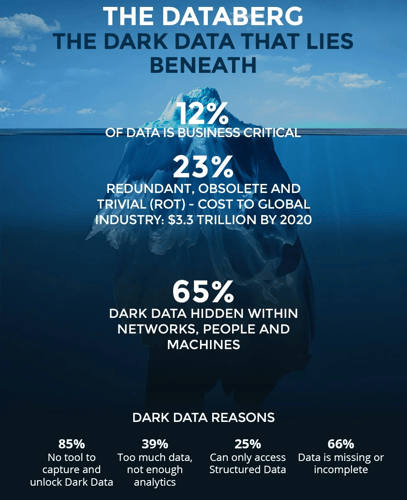What can your organisation do in the fight against climate change?
Blog Category: Information Security, Strategic IT & Operations, Privacy & Compliance

The announcement from COP26, that by 2023 big UK firms and financial institutions will need to outline how they get to net zero, has got us thinking. What can we enterprise data managers, governance and infosec professionals and strategic IT teams actually do to help reduce carbon emissions on behalf of our organisations?¹
And it sparked the idea of ‘sustainable data’. Because the fact is, that according to the Veritas Databerg Report, only 12%² of the data we have in our firms is actually business critical. The rest of it is either ‘dark’ (in other words no-one knows what’s in it or where it is stored) or it’s redundant, obsolete and trivial (ROT) so doesn’t need to be there at all.

According to the IDG, Data and Analytics Survey on average an enterprise organisation’s data estate stands at 347TB3. This equates to 11,357 kWh4 in energy consumption and contributes to the UK’s carbon footprint by over £1,7005 per year per organisation. For all enterprise organisations (250+ employees) this exceeds £18.6m per year.
In the summer of 2021, the Department for Business, Energy and Industry Strategy (BEIS) released a set of recommendations for businesses across the country to support the UK’s Net Zero Emissions campaign against climate change. One of these was that UK companies audit data and remove old, trivial, or redundant data that they no longer need.6
If we all took steps to discover and remove our redundant, obsolete and trivial (ROT) data, we could save 23% of storage costs (an immediate win) and significantly reduce our carbon footprint, because we’d need less servers to store all that useless data.
Furthermore, if we could find the dark data and bring it into the light, we’d not only be improving data quality, we would also be bringing down that number further. Most often made up of legacy data, created years before from long-forgotten activities, the vast majority of dark data is stored in data centres that need power 24/7.
The energy needs of data centres around the world equates to 1%7 of the global electricity demand. This is expected to rise unless dramatic steps are taken to ensure data centres are built in a more efficient way moving forward, or we all take responsibility for reducing the volumes of data our organisations store.
If we all make reducing our data estates a priority, we can get to a point where we only store ‘sustainable data’.
Find out how you could reduce yours. Contact us now to learn how Exonar can help.
Or try out our Data Storage Calculator.
Sources:
- https://www.bbc.co.uk/news/business-59136214
- Veritas Global Databerg Report Finds 85% of Stored Data Is Either Dark, or Redundant, Obsolete, or Trivial (ROT)
- https://cdn2.hubspot.net/hubfs/1624046/IDGE_Data_Analysis_2016_final.pdf
- Electricity Cost Per kWh | What Should You Be Paying? (theecoexperts.co.uk)
- How much energy does it take to store 1 Terabyte of data in the cloud? - Sustainable Living Stack Exchange
- https://londonnewstime.com/uk-companies-advised-to-switch-to-public-cloud-to-reduce-carbon-emissions/407128/
- Renewable Energy Alone Can’t Address Data Centers’ Adverse Environmental Impact (forbes.com)
Related articles
Seven predictions for data security and protection in 2022
Infographic: IT professionals disagree over their ability to keep businesses secure & remediate risk
Discover how we can help you
Take the next step

